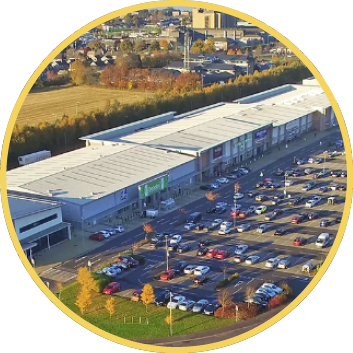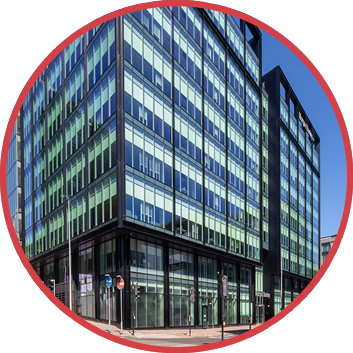
“One swallow does not make a summer…”
– Aristotle
Maybe so but it has certainly been an eventful summer! Since our last review – we have had a new UK Government, (two) attempts to shoot former President Donald Trump, further unrest in the Middle East and Ukraine advances into parts of Russia, more macro uncertainty. Yet despite all of this (and say it quietly), there are signs that we are finding some stability at the prime end of the commercial property market in Scotland.
One swallow might not make a summer but over the last quarter we have seen two significant deals in the office and logistics sectors to give investors confidence that, for the right product, then pricing in the prime sector is finding its level. The Mint Building (a prime office) in Edinburgh, was acquired by Pontegadea at 5.78% NIY, with short term reversion taking it through 6%. Similarly, Belgrave Logistics Park (a prime logistics park) in Bellshill, strategically located east of Glasgow, was sold by Knight Property Group in July at a market leading pricing, off rents with scope for medium term reversion.
We have not seen this sort of pricing in the market for several years and while it is very much focused at the prime end of the market, off reversionary rents with strong ESG credentials, it does feel like a watershed moment. To help give this some context, we are pleased to share a Q&A piece with Oli Lord, Head of UK Transactions at abrdn who is active across many sectors/geographies and gives an insight into what they are seeing and how the market may play out in the short to medium term.
Aristotle also wrote “Change in all things is sweet”. We are seeing a change in the market and as our new Prime Minister has recently said, let change begin…
Market Overview.
Key Themes
Prime finding its level – following a number of recent high-profile sales, pricing in certain sectors, namely:- Edinburgh offices, central belt logistics and long-leased PBSA has found a new stronger level, not seen for a number of years.
Further Corporate M&A activity – leading to an increase in motivated sellers, as new owners shape their portfolios to align with their sector-specific, wider strategic goals.
Debt availability improving – with more lending competition returning, debt is starting to look more attractive. The five-year swap rate at c3.5% plus a tightening of margins and LTVs at c55-60% is all helping to make debt accretive for better quality assets.
UK Funds re-emerge – for the first the time in several years we are seeing UK Funds acquiring prime assets across a range of sectors including supermarkets, logistics and PBSA. A shift in the political landscape has helped put Scotland back on the map.
The Housing (Scotland) Bill – going through Parliament, will hopefully see some sensible amendments (currently being mooted) which would ease the impasse in investment and see BTR re-emerge as an “investable” sector in Scotland.
Contractor failure – the recent collapse of ISG will have implications for new developments in Scotland (as well as the rest of the UK). Further stalling of new projects can be expected, making existing assets with “value-add” opportunity through refurbishment or re-purposing, even more attractive.
Transaction Volumes
Q3 saw £426m traded up 7% on Q3 2023.
Q3 volumes were 16% above the 5 year average.
A positive quarter with a number of larger ticket transactions, particularly in the office sector, resulting in the highest Q3 total in the last 5 years.
No Data Found
Pricing
Change is in the air and some confidence is returning to key sectors. We are seeing more solidity in pricing and even some hardening but very specifically focused at the very prime end of sectors such as Edinburgh offices, logistics and long-leased PBSA. This has definitely been helped by the return of UK Funds with their lower cost of capital/hurdle rates.
Demand for logistics and multi-let industrials remains strong in terms of depth of the buyer pool. Prime yields have sat at between 6-6.25% for some time but the sale of Belgrave Logistics Park in Bellshill has sharpened this to sub 5.50%.
Retail Parks and supermarkets remain in vogue and with overall vacancy rates at c1%, the rationale for investment is strengthening further. Funds including abrdn, Aviva and LaSalle are now competing with established buyers such as Realty Income and British Land which is holding pricing firm. 6.5-7% for the better parks and sub 6% for the best supermarkets with rental indexation. The High Street is also interesting but only in the strongest city centre pitches where rents have been properly rebased. Initial yields in the low 6’s with reversion to come is making sense.
In the Living sector, appetite remains robust for up and built stock, with development funding more challenging. Aviva’s acquisition of Gilbert Street in Glasgow (a direct-let) scheme has set a good benchmark at c6% and we are aware of a sale under offer of a long-leased asset in Edinburgh which will set a new low yield for this type of stock (significantly below 5%). The sale of Solasta in Glasgow (a 324 bed BTR development) is ongoing which will set a good benchmark for this sector and should be reported next quarter.
Buyer Activity
In terms of overseas buyers, the French SCPI’s continue to be very acquisitive accounting for c20% of total transaction volumes in Q3. With Scotland continuing to be on the radar for new entrants, we expect this trend to continue with recent activity in the office, industrial and retail warehousing sectors. We have also seen Spanish and North American equity completing transactions.
Within the UK – high profile corporate mergers & acquisitions is resulting in some of the REIT’s being net sellers of non-core assets, with the biggest (positive) change being the re-emergence of Fund acquisition activity. Property companies are starting to benefit from the improving debt landscape but the real effect of this has yet to be seen in completed deals.
Private equity is becoming more active, with a number of large portfolio acquisitions (including assets in Scotland) ongoing, which is likely to lead to more asset sales of non-core assets or sales once value-add business plans are complete.
Key Recent Transactions.
Q2 saw some interesting themes and significant transactions which we have highlighted below:

The Mint Building, Edinburgh
“Inditex founder acquires prime Edinburgh office”
Vendor: Hines HECF S.a.r.l
Purchaser: Pontegadea
Let to: FNZ, Nationwide, Tattu & Franca Manca
Price/Yield: £42.5m / 5.78%
Date: July 2024

Gilbert Street, Glasgow
“Continued appetite for direct let PBSA”
Vendor: PVP Developments
Purchaser: Aviva
Let to: Direct let PBSA
Price/Yield: £23m / 6%
Date: September 2024

Inshes Retail Park, Inverness
“Off market dominant retail park trades”
Vendor: Greenridge
Purchaser: British Land
Let to: Multi let anchored by B&M and Dunelm
Price/Yield: £28.75m / 7.37%
Date: September 2024

122 Waterloo Street, Glasgow
“French SCPI acquire leasehold HQ building”
Vendor: KFIM
Purchaser: Iroko Zen
Let to: Morgan Stanley
Price/Yield: £50.4m / 8.25%
Date: September 2024
The investor view on Prime finding its level…
Are you confident that pricing for prime assets across most sectors has found its level?
No Data Found
65% of respondents believe prime assets have found their level, not overwhelming but a solid majority with only property companies close to a 50/50 split.
Funds and investment managers are most bullish with three quarters of investment managers and close to 90% of fund respondents believing pricing has indeed found its level.
It was noted that further evidence at the prime end of the market will result in increased pricing confidence and that recent prime evidence has been restricted to the office, logistics and PBSA sectors. We expect evidence created in the retail & supermarket sectors during Q4, to provide a benchmark for prime yields in these sectors.
Do you expect improved pricing certainty to lead to greater liquidity in the market?
No Data Found
Perhaps unsurprisingly, the overwhelming majority (93%) of respondents expect to see improved pricing resulting in greater liquidity in the market.
After a turgid start to the year, Q3 saw the first signs of an improvement in sentiment amid a number of significant sales in the market. There are signs fund raising is becoming easier and although equity buyers continue to make up the bulk of the buyer pool, we are starting to see debt backed investors dipping their toes back in supported by more attractive terms. A lack of pricing clarity earlier in the year led to vendors holding back a number of sales and with pent up demand, Q4 should see the traditional uptick in transactions.
With the first Labour budget coming on the 30th October widely expected to see the government announce an increase in Capital Gains tax (and potentially Stamp Duty), along with the release of inflation data on 16th October preceding the next Bank of England Monetary Policy Committee meeting on 7th November, the next 6 weeks will go a long way to determining market sentiment heading into 2025.
In this recovery cycle, which sectors have the strongest fundamentals for yield compression?
No Data Found
The industrial/logistics sector has been the stand out performer over the last 12 months with prime yields hardening by c100bps from the low point in late 2023. The sector has continued to attract interest from a diverse range of investors including property companies, high net worth privates and sector specialists. With rental growth coming through and a lack of speculative development constraining supply, the potential for yield compression is there.
The Living sector continues to be targeted by a wide base of investors attracted by a resurgent hotel market post Covid-19, with yields settling c6% for long let city centre hotels and trending downwards . We are already seeing PBSA yields begin to sharpen, with a significant long leased PBSA sale due to complete in Q4 which will reflect a yield of sub 5%.
There was less confidence in the office and retail sectors which were the two sectors backed the least. However, recent evidence shows yields are starting to sharpen, in the very best locations, with genuine reversion to come in the short term.
“Expert view” on investment in Edinburgh…

Oli Lord
Head of UK Transactions
abrdn
Prime is an often overused term, what are the hall marks in your opinion of a truly prime investment?
Fundamentally, initially it is location, whether it be transport links or amenity for staff, customers and residents or transport links for supply and distribution to and from the asset.
After location, the qualities for the definition of prime, clearly differ for each sub sector. However, in terms of amenity, it needs to be high to attract and retain the end user, whether staff or customer. The level of amenity within an office clearly attracts increased significance in order to encourage staff into work.
High levels of ESG qualifications are a key component of the prime definition and again differ in each sub sector but BREEAM and EPC ratings are applicable in most core sectors and are recognised standards that effect liquidity.
A prime investment could also be considered as assets that attract and retain tenants and the qualities above should achieve that and the qualities will allow higher rents, which by their nature will attract stronger tenants, another key component of prime.
With several assets recently transacting, do you believe prime has found its level?
With the weight of capital waiting to deploy in real estate and direction of interest rates, it certainly appears we have turned the corner on pricing as we go into Q4 and towards next year. To secure prime stock now, purchasers are having to pay an element of ‘tomorrow’s pricing’ to close the gap towards Vendor expectations, who are aware of an improving market.
With the direction of fiscal policy a bit clearer, purchasers are willing to push pricing to secure stock ahead of what could be a more competitive market next year.
Certainly recently in the retail warehouse and industrial market we have seen evidence that these sectors are kicking on, driven on by low vacancy, rental growth and the ability to capture reversion. The exception we believe is the office market , which has been under considerable pressure, but there is evidence to suggest that for truly prime office assets, pricing has found its level.
We believe that activity will rebound in Q1’25, in-line with market expectations for interest rate cuts, and create further evidence of pricing for prime assets. It is clear that institutional investors are focussing on best-in-class space which we believe we result in inward yield movement for truly prime assets in the most favoured areas of the market.
After a subdued year to date, do you anticipate a particularly busy Q4 or expect investors to keep their powder dry until they have clarity around a further interest rate cut?
The issue is not investors keeping their powder dry because the weight of capital is strong and there is increased confidence in the current cycle and a view that we are at the bottom of the cycle.
The issue is the availability of stock as vendors expect better pricing in 2025 and there is still no huge pressure to sell with redemption sell down windows being managed into next year, when there will be better pricing achievable and an expectation of further cuts and debt becoming accretive which will further fuel pricing. There is a desire to get in now before the full effects of this are realised but the issue is stock availability.
Our economic team forecast one 25bps cut this year which will take the base rate to 4.75% by the end of 2024. The market is currently pricing in two cuts at this stage, but both the abrdn Global Macro Research team and the market anticipate around 100bps of cuts in 2025. With that in mind, we believe that the market is waiting for more meaningful evidence that interest rate cuts will come through, which will likely result in investment market activity to pick up in Q1’25, rather than a stronger Q4’24.
However, there should be a slight increase in stock levels as some Vendors look to take advantage of low stock and with the timeline to meet redemptions shortening and portfolio / fund purchasers looking to sell non-core strategy assets, it could encourage further stock to come, but on the whole we expect much more activity in 2025.
Going into Q4, which sector do you see attracting the strongest investor interest?
We don’t expect Investor interest to change from what we have previously seen and it will predominantly remain narrowly focussed on industrials, living and retail parks. We expect that this trend will continue given the stronger underlying occupational fundamentals of low vacancy and the prospect of rental growth from the limited supply of truly best-in-class space.
As an asset manager, what initiatives are you undertaking to ensure assets retain their prime status during your hold period?
The main priority for us is maintaining and increasing liquidity and for us this is making ESG improvements and increasing EPC ratings in light of forthcoming regulation changes. These improvements should also help with retaining and attracting tenants. It is also about thoughtful and comprehensive refurbishments to meet tenant’s demands and reduce their future capex.
“Our view” on prime finding its level…

Chris Thornton
Associate
Lismore Real Estate Advisors
Has prime found its level?
The recent sale of The Mint Building to Pontegadea for £42.5m / 5.78% and Belgrave Logistics Park, represent market leading sales in the office and logistics market respectively, together with an ongoing PBSA sale at pricing significantly keener than 5% NIY, should give some confidence that prime has found its level.
Whilst only a handful of transactions, these sales do illustrate that there is liquidity at the prime end of the market which has been lacking for the last couple of years.
Will Q4 see the commercial property market continue to stabilise?
A further cut to interest rates is anticipated before the end of 2024 providing greater confidence to debt backed investors, with rates forecast to reach 4.75% by the end of 2024 and 3% in 2025, with further, meaningful cuts forecast in 2025. The return of debt becoming accretive to investment decisions coupled with lenders searching for opportunities to place money should bring activity resulting in improved liquidity in Q4.
We are seeing the green shoots of an improvement in sentiment, however the affect of the continuingly volatile geo-political environment has the potential to cause further volatility in the months ahead.
How has the investor mix changed over the last 6 months
A notable trend we’ve seen are UK funds once again becoming active in a number of sectors, with the likes of Aviva and Schroders sensing opportunity in the Scottish market. A major driver of this re-emergence has been the receding Scottish nationalism with the question of Scottish independence seemingly put to bed for a generation. This political stability coupled with prime yields showing a discount of 100-150bps softer than key markets south of the border, is proving compelling.
French SCPI’s have continued to be active with the likes of Remake, Corum and Iroko Zen targeting the logistics, office and retail warehousing sectors. Other active investors from North America, Spain, GCC and Germany to name but a few, illustrate the diversity of the buyer pool.
How has the wider market been effected by recent mergers and acquisitions?
Over the last 6 months we seen a number of high profile mergers & acquisitions including Tritax Big Box acquiring abrdn’s UKCPT, Lone Star acquiring the Charles Street Buildings portfolio, LetterOne buying the majority of ‘Project Endeavour’ from British Airways Pension Scheme and Starwood acquiring BCPT. The abrdn Property Income REIT have now agreed a sale rather than pursuing a structured wind down.
Inevitably, M&A’s lead to new owners holding a proportion of non-core assets which don’t align with their investment strategy, resulting in sales of these properties. In Scotland, we have seen London Metric’s acquisition of LXi result in the sale of two long income offices to Remake Asset Management let to BT & STV and Tritax bringing 81-85 George Street in Edinburgh to the market, a trophy city centre office & retail block.
How is the limited contractor market impacting?
The recent collapse of one of the largest contractors operational in the Scottish market and the sixth largest in the UK, ISG, further tightens an already limited contractor offering. The highest profile collapse in the UK construction sector since the fall of Carillion in 2018, the wider implications on the supply chain will only be clear further down the line, however the impact on smaller firms is likely to also put their futures at risk. Too big to fail has been proven wrong time again and at the time of its collapse, ISG held more than £1bn of UK government contracts.
In addition to ISG, a number of smaller contractors have collapsed over the last 12 months, in some cases leading to practical completion being delayed by 12 months or more. Given the existing development headwinds and lengthy timelines for delivery, the loss of a major contractor will only exacerbate this, placing a greater emphasis on refurbishment/light touch redevelopment.
Going into Q4, which sector do you see attracting the strongest investor interest?
It’s likely the industrial/logistics sector will to continue generating the greatest depth of buyer pool, with the buyers focusing on the key central belt locations such as Eurocentral, Bellshill and Cambuslang, with the prospect of strong rental growth in the short term providing attractive to IRR driven investors. Elsewhere the Living sector, specifically PBSA in Edinburgh and Glasgow and well located long income hotels offering indexation will remain in demand.